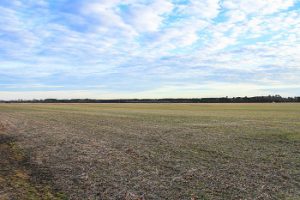Navy, State and Nonprofits Partner to Conserve Land in Dorchester County
Farm Links Protected Areas to Create a 7,730-acre Corridor of Conserved Lands
A partnership between the U.S. Navy, Maryland Department of Natural Resources, The Conservation Fund, The Nature Conservancy, and the Chesapeake Conservancy has led to the permanent protection of 230 acres on a family-owned farm in Dorchester County. Spread over three parcels, the farm is made up of 135 acres of prime agricultural fields and 85 acres of forest in the Nanticoke River watershed, one of the Chesapeake Bay’s most pristine landscapes and an important habitat for migratory birds.
The property provides a key connection between two large ecologically important areas that were previously protected, creating an approximately 7,730 acre corridor. Protecting large conserved areas is important for the health of the Chesapeake Bay watershed given recent trends of urban expansion, species decline, loss of agricultural lands and habitat conversion and fragmentation. The perpetual conservation easement allows the property to remain in agricultural use but limits future residential or commercial development.
This corridor of protected land is near a common flight path for aircraft out of the Naval Air Station-Patuxent River and beneath the Atlantic Test Ranges special use airspace. As such, this area is part of the Middle Chesapeake Sentinel Landscape designated by the Departments of Agriculture, Defense, and the Interior that spans portions of Maryland, Virginia, and Delaware.
The national Sentinel Landscapes program is a unique public-private partnership designed to preserve the working and rural character of key landscapes and conserve habitat and natural resources. Sentinel Landscapes protect vital test and training missions conducted by military installations, while minimizing the impact of testing on residents. There are currently seven Sentinel Landscapes in the nation, including the Middle Chesapeake.
The Nature Conservancy and The Conservation Fund managed the creation of the easement in partnership with the landowners. The easement purchase was made possible by a combination of federal funding through the Department of Defense’s Readiness and Environmental Protection Integration (REPI) program, state funds from Maryland’s Rural Legacy Fund and private funds from the Chesapeake Conservancy, through a land conservation grant from Mt. Cuba Center.
“We are pleased to be able to participate in this project and work with local communities on the Eastern Shore to protect not only family farms and forests, but to ensure the viability of our Navy flight test and training mission at Naval Air Station Patuxent River and in the Atlantic Test Ranges,” said Melanie Anderson, REPI Program Lead at Atlantic Test Ranges, NAS Patuxent River.
“This is an ideal use of Maryland’s Rural Legacy Program, which fosters public-private partnerships to determine the best way to protect our state’s landscapes that are critical to our economy, environment, quality of life — and in this case, even our national security,” said Maryland Natural Resources Secretary Mark Belton.
“It is a privilege to work with a family that has farmed for generations and is dedicated to preserving their agricultural legacy,” said Elizabeth Zucker, Conservation Director for The Nature Conservancy on Maryland’s Eastern Shore. “Thanks to the strong collaboration between state, federal and private partners, we’re thrilled to help make preservation opportunities like this available to landowners in an important Chesapeake Bay landscape.”
“Conserving this farm aids the military’s need to test aircraft while benefiting local communities and conserving our environment,” Chesapeake Conservancy President and CEO Joel Dunn said. “It’s a win-win situation for the Chesapeake Bay, the state of Maryland, and for the nation.”
“Preserving large areas of open space provides critical habitat for a wide range of native plants and animals,” Mt. Cuba Center President Ann Rose said. “It is inspiring to see collaborations like this one come together to make a real difference for our local environment.”


 1-888-373-7888
1-888-373-7888 233733
233733